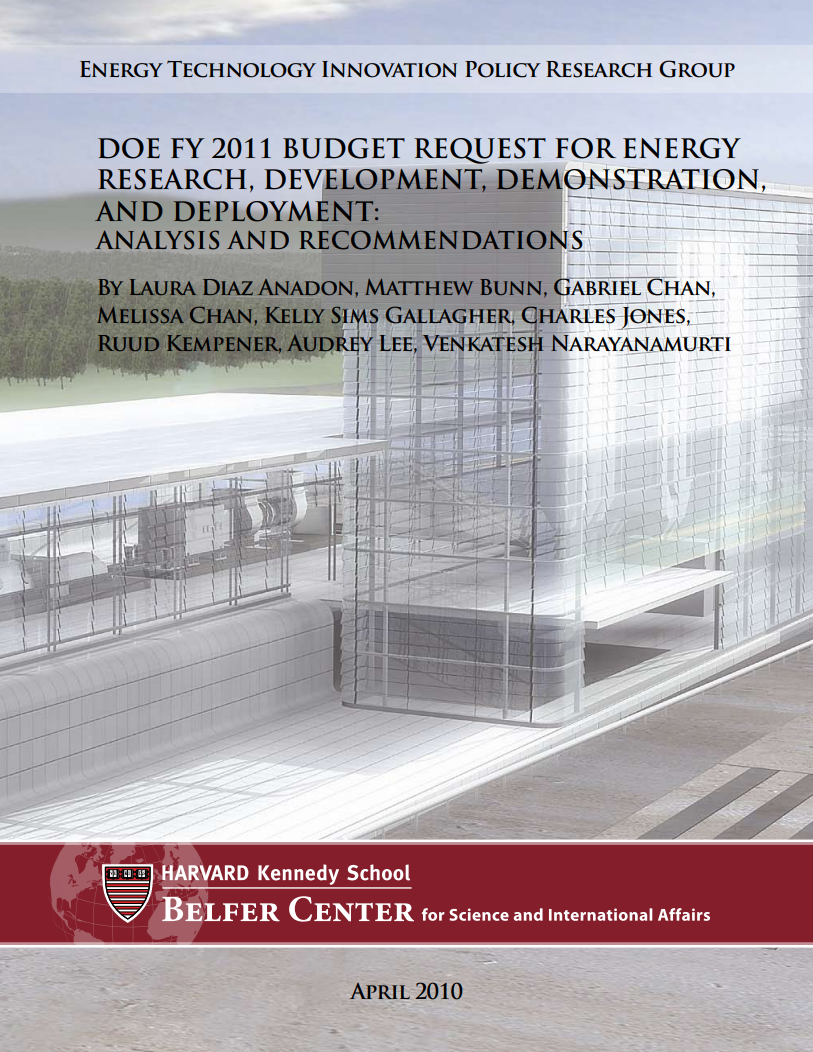DOE FY 2011 Budget Request for Energy Research, Development, Demonstration, and Deployment: Analysis and Recommendations
Recommended Citation:
Anadon, Laura Diaz, Matthew Bunn, Gabriel Chan, Melissa Chan, Kelly Sims Gallagher, Charles Jones, Ruud Kempener, Audrey Lee, Venkatesh Narayanamurti. 2010. DOE FY 2011 Budget Request for Energy Research, Development, Demonstration, and Deployment: Analysis and Recommendations. Report from the Energy Technology Innovation Policy research group, Belfer Center for Science and International Affairs.
Abstract
In spite of the difficult fiscal situation, President Obama’s FY 2011 budget request for energy research, development, and demonstration (RD&D) would increase funding for applied energy RD&D programs by 7% over the FY 2010 appropriation, to $3.9 billion. Most of the increase in the applied programs comes from the $300 million that would be allocated to ARPA-E. Funding for basic energy science research would increase by 12%, to $1.8 billion. Combining one-third of the funds provided by the American Recovery and Reinvestment Act of 2009 (ARRA) for basic energy sciences, energy RD&D programs, biological and environmental research, and energy technology deployment—roughly the amount expected to be spent during FY 2011—the FY 2011 request would result in total investments of over $17 billion, which exceeds President Obama’s campaign promise to invest $15 billion a year for energy technology innovation. Once the ARRA funds are spent, however, it is unclear how current levels of investment in energy technology innovation will be maintained. The modest 7% proposed increase in applied energy RD&D spending is certainly needed, but remains well short of the large and sustained investment likely to be required to transform U.S. and global energy use and production and to meet the climate, energy availability, and energy security demands of the twenty-first century. In real terms, the support for basic and applied energy RD&D would remain 30% below the 1978 level, the peak of government funding for energy RD&D in the United States. (See Figure 1).
The combination of support for ARPA-E with $107 million for the new Energy Innovation Hubs and continuing support of $140 million for the Energy Frontier Research Centers indicates that DOE and administration leaders are rightly taking a portfolio approach to the mechanisms used to fund energy RD&D. There is still an urgent need, however, for an improved institutional approach to managing large-scale demonstrations of new energy technologies; greater funding and strengthened coordination for international partnerships for energy technology innovation; and a more strategic approach to allocating and evaluating DOE’s partnerships with the private sector. In addition, while the funds in ARRA would support several carbon capture and storage demonstration projects (which will hopefully be carried forward), additional funding for demonstrating this technology at scale in a range of different geologies and configurations is likely to be required.
Keywords
federal budget, ARRA RD&D, ARPA-E, US Department of Energy

